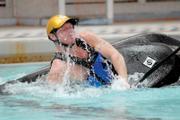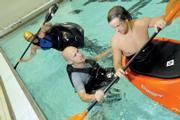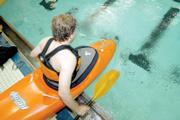I've been canoeing and white-water rafting, but the solitary pleasure of kayaking has always appealed to me.
Although I had never kayaked, during my canoeing and rafting expeditions, I would watch kayakers zoom by, captains of their own adventures. So, after moving to The Natural State, kayaking was a pastime I wanted to learn more about.
Luckily, the Arkansas Canoe Club's Central Chapter is always ready to help a newbie learn the sport and enjoyment of kayaking. After a few brief phone calls and e-mails, I was hooked up with an instructor and kayaking equipment for a Saturday afternoon roll session at the University of Arkansas at Little Rock's Donaghey Student Center, a center with central Arkansas' only Olympic-size pool. The university allows club members to use its pool to practice their kayaking skills.
My instructor one recent Saturday was Heather Huckaba, a kayaker since 2005. I borrowed a kayak from Arkansas Canoe Club Central Chapter President Mike Stanley.
Before we even entered the aquatics center, Huckaba offered me a crisp fact about rolling a kayak: "Rolling is counterintuitive."
And her next statement corrected me on a misconception I had that rolling a kayak might be easy.
"We're going to give it our best shot," Huckaba said. "We might not roll in one session."
Since I had never been in a kayak, I was not as graceful as I had imagined when I slipped into the water and started paddling around. At first I wobbled but never toppled, clumsily paddling around the shallow end of the pool, gaining my kayaking legs.
After about 15 minutes of acclimating myself to the kayak, I was ready for the first lesson of kayaking - and one I would put to good use throughout the day - performing a wet exit.
Wet exiting is a three-part process: With the kayak capsized, lean forward over the front of the kayak, almost kissing it, grab the sprayskirt and pull it out, releasing it from the lip, and then exit the boat.
Although I was snug in the kayak, when it came to performing my first wet exit, I was out very quickly. I felt confident in myself, having mastered the wet exit, but my inflated sense of confidence would suffer a blowout when it came to practicing and attempting a kayak roll.
A kayak roll is a series of steps, a process performed in one fluid motion while the kayaker is submerged. The first step is the set-up, where the head and torso is leaned forward into a crunch position and the paddle is held with both hands parallel to the kayak. The next step is performing the sweep. While simultaneously sweeping the front end of the paddle out from the boat in a circular motion, the kayaker curves the torso along with the paddle sweep from its curl position at the front of the boat to a leaning back position at the back of the boat while lifting the torso out of the water. In the process, the hips "snap," rolling the kayak back upright.
It's not about using the arms and paddle to upright the boat, but it's all in the knees and the torso.
I got the set-up down pretty quickly, but I lacked the necessary hip "snap," the critical component in uprighting my capsized kayak. Also - and unluckily for me - the head should be the last object out of the water, but I always wanted to flick it up too quickly.
"It's not physically hard to roll," Huckaba said before we got started. "It's more about the technique and the finesse. You're not going to muscle it. You use your torso and your leg muscles."
After practicing for about an hour and a half, I still had not come close to synchronizing my torso and hip "snap," so I never performed a kayak roll - at least during my first roll session.
But, according to Huckaba and Stanley, most first-time kayakers don't manage a roll until they have practiced it extensively. In fact, children usually can grasp a kayak roll more quickly than adults since they don't have any nasty habits to unlearn.
So following my first (but not my last) attempt at learning how to roll a kayak, I have a new appreciation for the skill and eagerly look forward to practicing kayak rolling more.
Check the Arkansas Canoe Club message board at www.arkansascanoeclub.com for more information on UALR pool sessions and other club information.


